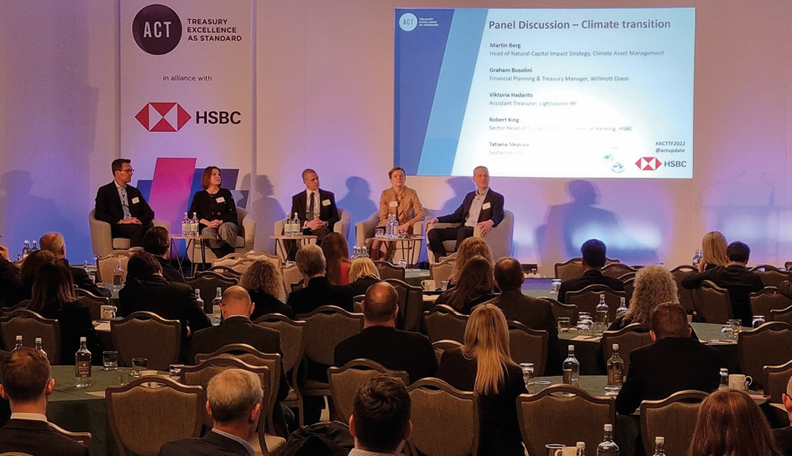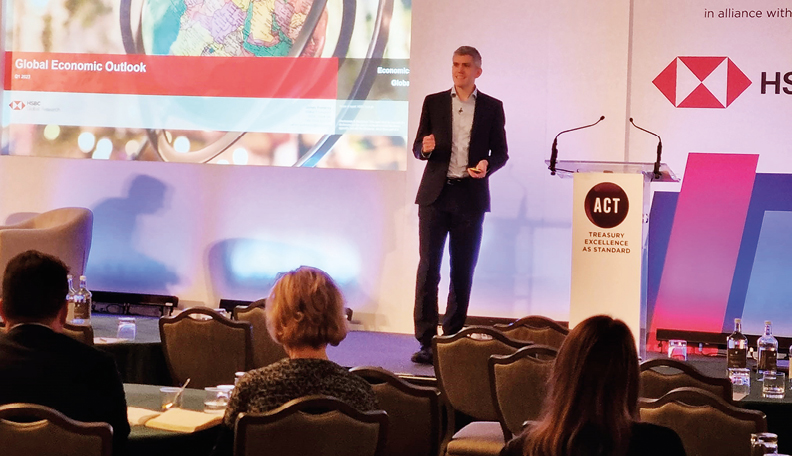If any treasurer required evidence that environmental, social and governance issues should be firmly on their agenda, it came at the recent ACT Treasury Forum,
hosted in alliance with HSBC.
While the experienced treasurers in the room had the opportunity to discuss a wide range of subjects, including political and economic uncertainty, it was the impact of climate change and the transition to net zero that was arguably at the front of many treasurers’ minds. “The treasurers’ role in navigating this transition is very important,” James Mortimer, HSBC’s UK head of corporate banking, told the audience.
Introducing the panel discussion dedicated to climate transition, Robert King, HSBC’s UK head of sustainable finance, said: “We have seen strong growth in sustainability finance in recent years, with some $700bn of sustainability-linked bonds issued in 2021, that’s one in 10 of all bond issuances.”
It is, he said, a market that simply did not exist five years ago. 2022 saw a downturn in issuance, but the market is expected to come back again in 2023. Working with a wide range of clients, from FTSE 250 companies to SMEs, King is seeing activity beginning to increase.

Tatiana Slepova, HSBC’s sustainability lead for Europe, added that companies could expect more sustainability-related questions from their banks regarding their transition strategy, and potentially about a company’s KPIs in this area. How banks can help their clients on their transition to net zero will become an increasingly important part of this process.
Even the providers of green energy needed to be aware of this changing environment. Viktoria Hadarits, assistant treasurer at Lightsource bp, a global leader in solar development and management, told the forum how even a solar business needs to have net-zero targets. “We provide solar energy to companies to help them on their net-zero journey, however, that doesn’t mean that we don’t have to worry about our own journey,” she said.
“In 2021 we published our sustainability framework, which included the three key pillars of the company – people, environment and energy. Building on the sustainability framework in 2022, we have published our first annual sustainability report, confirming the sustainable development goals that we support in our operations. And we have published the first numbers around our own greenhouse gas emissions and set ourselves some KPIs on how to reduce them over the coming years.”
Hadarits described how, when she joined the Lightsource bp team, she made a point of understanding the company’s net-zero journey. “It is very important for the treasury team to be aware of the goals and objectives of the company so that… having people with a sustainability mindset within the treasury team will help embed those [sustainability] processes much faster within our function.”
Examples of sustainability processes include how excess cash is invested, including the use of ESG-based money market funds and ‘green’ bank deposit accounts that can support sustainability development goals. She is also looking at foreign exchange products that can be linked to existing sustainability KPIs so that some funds can be returned to the business via a rebate system, which in turn will be used to support the sustainability objectives of the company.
“This is where I see our banking counter-parties helping us, through informing us about the latest innovations and products in the market,” she said. “Having full visibility of what is out there in the market will help us make good decisions.”
Transition pathway
Other panellists agreed that treasurers needed to know and understand their own organisation’s sustainability framework and where the organisation is on its transition pathway. They can then understand where and how finance fits within this. For instance, a revolving credit facility (RCF) can be linked to sustainability elements, with margins flexed up or down depending on performance against sustainability KPIs. Treasurers can also ensure their organisations invest surplus cash in ESG-related funds, and even help employees with their own investments, such as pensions, so that they are comfortable with where their money is invested.
Then there is the supply chain, which is going to become an area of increasing focus as organisations begin to report on their ‘Scope 3’ greenhouse gas emissions. However, there are other fundamentals such as ensuring suppliers are paid on time and absorbing short-term increases in costs, weighed against the long-term goal of net-zero.
The forum also heard how biodiversity loss is set to become an area of increasing focus for many companies, as the Taskforce on Nature-Related Financial Disclosure (TNFD) continues its work to develop and deliver a risk management and disclosure framework for organisations to report and act on evolving nature-related risks. Corporates and the financial sector will need to look at this area in greater detail, in the same way that they are currently looking at how climate change can impact the supply chain. The TNFD is aiming to publish its recommended framework in September 2023.
Ultimately, climate transition could be a bumpy road for many corporates, the treasurers heard. These organisations will have to make hard choices, but one of the keys to success will come with the alignment of finance with their sustainability strategy. While there may not be a need to “re-invent the wheel”, there will be the need to ensure these strategies, and the KPIs against which they will be managed are robust, a process that could create new opportunities for the treasury function.

Glimmer of hope
The discussions on climate transition, alongside other topics such as credit risk, inflation, export finance, supply chain disruption and the metaverse, were held against the background of ongoing economic and geopolitical instability. However, there was a growing feeling of optimism among the speakers and attendees that there were positive economic signals appearing.
As James Pomeroy, HSBC’s global economist, told the audience: “The economic outlook is dark, it is uncertain, but there is a glimmer of optimism.” Uncertainty was, however, Pomeroy’s watch word – growth is uncertain, inflation is uncertain and therefore it is very uncertain what central banks will do to combat inflation. “But the economy has kept turning despite all these challenges. The big question in 2023 will be whether this will continue,” he said.







